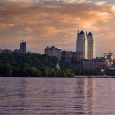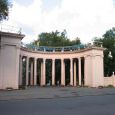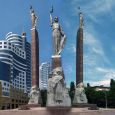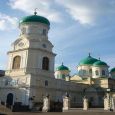Dnepropetrovsk
Advertisement
By Air
The city is served by an Dnipropetrovsk International Airport (IATA: DNK) and is connected to other European cities with daily flights.
By Railway
The city is a large railway junction. Daily trains run to and from many parts of Eastern Europe. There are two railway terminals, "Dnipropetrovsk-Main" and "Dnipropetrovsk-Yuzhnyi". Two rapid trains at day time from Kiev to Dnipropetrovsk and there are a few express trains at night. Trains come from Lviv, Simferopol, Odessa, Ivano-Frankivsk, Truskavets, Donetsk, Minsk (Belarus), Moscow (Russia) (st. Kursky), Saint Petersburg (Russia) (st. Vitebsky), Baku (Azerbaijan), Varna (Bulgaria) and other places.
By Bus
The largest bus station in eastern Ukraine is located in Dnipropetrovsk. It is near the city's Central Railway Terminal. Bus routes are also available to all over the country, including some international routes to Russia, Poland, Germany, Moldova and Turkey.In the summertime, there are some routes available by hydrofoils on the Dnieper River. Various tourist ships on their way down the Dnieper, (Kiev–Kherson–Odessa) always make a stop in the city.Dnipropetrovsk has some highways crossing through the city. The most popular routes are from Kiev, Donetsk, Kharkiv and Zaporizhia. Transit through the city is also available.
Advertisement
Yavornitskiy History Museum
In the Dnipropetrosk History Museum, Hall 9 is devoted to the millions who perished in the Soviet period. Representative individuals have documents related to their disappearances, trials and executions distributed around the walls.Villans are named: Stalin, Brezhneov, Kruschov.These testaments are very sobering. But the focus of the room is a pyramid made of photos of faces, each lit by a small candle-bulb.It is not a place to hurray. It is more a space for reflection and contemplation.There are benches so sit and think for a while, "What can I do so this never happens again?''.The exhibits here are mostly due to the permanent director researcher, historian, archeologist and writer, D. Yavornitskiy after whom the museum is now named. He spent his life gathering the articles which were disappearing from the Ukrainian landscape and lifestyle. It is a rich place because of this one man's efforts.
Monastyrsky Island
is the most famous place in Dnepropetrovsk. It is rocky in its upper part, sandy at the back, for centuries the island had served as a stop to rest on complicated trade or military ways along Dnepr River.The right embankment stretches for over 23 km, it is the longest embankment in Europe. It is interesting that till early 1960s Dnepropetrovsk seemed to turn back from the river: endless store-houses and small plants were located along Dnepr, there were no recreation areas and the river was used only as a waterway. But the fact that the city was an industrial giant and saved a lot of slag - waste of metallurgy - enabled to form and fix the bank with a wide boulevard.
Dnipro Arena
Dnipro Stadium is a football stadium in Dnipropetrovsk, Ukraine. It is mostly for football matches and hosts the homes matches of FC Dnipro Dnipropetrovsk. The stadium has a capacity of 31,003 people. It replaced Dnipro's old stadium Stadium Meteor.It staged the World Cup qualifying match between Ukraine and England as the Olimpiysky National Sports Complex in Kiev was being rebuilt ready for Euro 2012.The Dnipro Arena was chosen as a possible venue for Euro 2012, but was dropped from the list in May 2009. The capacity fell short of the minimum 33,000 seats required by UEFA.
Kodak Fortress
was a fort built in 1635 by the order of Polish king Władysław IV Vasa and the Sejm over the Dnieper River, near what was to become the town of Stari Kodaky (by modern day: Dnipropetrovsk, Ukraine). It was constructed by Stanisław Koniecpolski to control Cossacks of Zaporizhian Sich, prevent Ukrainian peasants from joining forces with the Cossacks and guard the southeastern corner of the Polish-Lithuanian Commonwealth. The Poles tried to establish order in that area, and commissioned French military cartographer and engineer William le Vasseur de Beauplan to construct it. The fortress cost around 100,000 Polish zlotys. The dragoon garrison was commanded by the French officer Jean de Marion.
Information not available
Information not available
Advertisement








